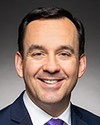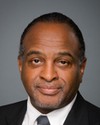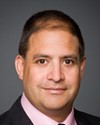Thank you, Mr. Chair.
Clause 2 of the bill reads as follows:
2. Section 65 of the Criminal Code is renumbered as subsection 65(1) and amended by adding the following: (2) Every person who commits an offence under subsection (1) while wearing a mask or other disguise to conceal their identity without lawful excuse is guilty of an indictable offence and liable to imprisonment for a term not exceeding five years.
We suggest the following amendment:
That Bill C-309, in clause 2, be amended by replacing lines 10 to 13 on page 1 with the following: (2) Every one who, with intent to commit an offence under subsection (1), has his or her face masked or coloured or is otherwise disguised is guilty of an.…
It then continues with what is in the bill.
Bill C-309, a private member's bill, was tabled by the colleague here. I would like to thank him for taking this initiative. I think that violent demonstrations, like the recent demonstrations in Victoriaville, Montreal and elsewhere in Quebec, the ones in Toronto during the G8 and G20, and even the riots in Vancouver after the Stanley Cup, are horrifying to almost all reasonable, law-abiding Canadians. The members of the official opposition, of the government and of all other parties in Parliament agree that we need to find ways to tackle this problem.
We understand the logic underlying this bill. Last weekend, the justice minister, the honourable Rob Nicholson, said that the government would support this bill. However, as a sidebar, I would like to say that this kind of bill, in the context in which we could even create new offences, should come from the government and not through the back door from a member. Having said that, I give full marks to the colleague who tabled Bill C-309 for his intentions.
It's obvious that the objective is to prevent people with bad intentions from wreaking havoc during demonstrations that are initially very peaceful and entirely lawful. This situation has become more and more frequent for a few years now. I am convinced that there will always be people with bad intentions, everywhere. Can the bill prevent that in its current state? The way several witnesses—even police force representatives—understand the bill indicates to us that there is a problem with how it's interpreted.
The way the bill currently is, the individual must at least intend to participate in a riot. We can refer to the Criminal Code and all jurisprudence that has been decisive in the case of section 65. But the arguments will be basically the same for section 66. Professor Stribopoulos told us earlier that there had to be criminal intent. In other words, we can't give police forces carte blanche.
Some people listening to us may think this bill will allow any police force to unmask everyone or remove their disguise simply because they are taking part in a demonstration that turns into a riot or an unlawful assembly. But I have the impression that the courts are going to set the record straight and that it may cause some problems.
In addition, the fact that the Criminal Code has similar provisions that are worded differently creates ambiguity. Again, I think Professor Stribopoulos spoke about this in his testimony.
More often than not, this ambiguity is used only by the defence. It is used to raise reasonable doubt, create confusion, mask, if I may use the word, what we are trying to unmask. That isn't the objective that the legislators want to attain. Our role is to use the best terms possible, words that don't leave room for interpretation. You may tell me that this is somewhat idealistic, and that may be. If that was the case, there would no longer be any trials and everything would be very clear. However, it is our duty to ensure that the legislation that we draft here, in Parliament, will be legally binding and beneficial for the people we represent and that they will respect all the legislation that can be applied in the circumstances.
The government has talked at length about what is being done in other countries, including England and Australia or in New York City, in the United States, and so on. We are all aware—and I imagine the government is too—that we have the Canadian Charter of Rights and Freedoms. I didn't call it the "charter of criminals". This charter, which is for all Canadians, stipulates that people have the right to express themselves without fear of getting beaten up for having a different opinion.
This committee recently passed a bill that removed hate speech to foster—and that was the government's argument—freedom of expression. Freedom of expression takes many forms, including how we dress and speak. Having said that, the objective is to ensure that there is as little confusion as possible. Clearly, there is the matter of burden of proof. Subsection 65(2) of Bill C-309 states: "Every person who commits an offence [so, who participates in a riot and intends to participate in one] while wearing a mask or other disguise to conceal their identity without lawful excuse…."
So it will have to be proven that this person tried to conceal his or her identity without lawful excuse. There is a burden of proof. Representatives from the Canadian Bar Association made that very clear to us. I encourage the members who did not read their brief to do so. We got it yesterday, May 7. I wish they could have come and met with us. I think the brief is fairly clear on that. The problematic issue of reversing the burden of proof may be challenged. This may lead to some problems relating to the constitutionality of the bill.
To stay within the specific context of Bill C-309, as I've said from the beginning, the tools already exist for police officers everywhere. The problem is often not that the Criminal Code provisions don't exist, but rather that there are many more people than expected and that there isn't much communication among the demonstration organizers. That should be one indication, by the way.
Let's take the students in Quebec as an example. Police chiefs said that, sometimes, they couldn't contact the people in charge of the demonstrations. If I was a police officer, knowing that a demonstration was going to take place, I would monitor things much more closely because a lack of communication is a sign that there will be problems. That would make me a little more cautious about what action I would take. I would add police officers or I would ask other police forces for help.
In addition, our bills shouldn't mask the fact that there is a real lack of police officers.
There aren't enough police officers or boots on the ground. This isn't the first time we've heard that. The government even made promises about that during the election campaign. So we shouldn't be hiding these gaps with bills that fool Canadians into believing that it won't ever happen again.
When people ask me that if Bill C-309 were to be adopted as is, could events like what happened last weekend in Victoriaville happen again, my answer has to be yes. Would the consequences be the same? If we are able to catch the instigators and the guilty parties, I say good luck. It isn't necessarily easy. It's not a panacea.
This is why we think that we aren't resolving the problem by having a text that is like one that already exists. We've been saying from the beginning that the section exists and that it has already been used. It has been used successfully more than once, according to some witnesses.
If we insist on creating two new offences, including in section 65(2), we need to at least have wording that doesn't contradict another provision because then we will really cause a problem. Does it become a lesser and included offence? Is it a choice? Are these the two offences that police officers will be able to work with? While here, it's clear. The clause says that everyone who, with intent to commit an offence under subsection (1), has his or her face masked or coloured or is otherwise disguised is guilty of an indictable offence.
So that remains faithful to what our colleague presented, meaning that an offence would be created. We think it already exists. So it's a little redundant. However, let's say that we are going to establish it specifically in the context of the section on riots and unlawful assemblies. This might eliminate some discussions that some people could potentially have about the provisions of section 351, which have more to do with offences like armed robbery and things like that.
If we insist on having this new type of provision, thinking that we're creating something new, at least let's do it in respect of the charters, of the right to assemble and to express ourselves, while ensuring that people who are arrested are prosecuted under the full extent of the law, but in accordance with the laws that exist here, in Canada.
As I just said, we think what's important is ensuring that this doesn't happen again. But if it does happen, what tools could the police have? What types of tools do they need to be able to tell the population that it's a problem if they take part in this type of event and wear a disguise.
By the way, this is more consistent with what was in section 351. If I was a defence lawyer and saw the words "while wearing a mask or other disguise to conceal their identity", while section 351 says "his or her face masked or coloured or is otherwise disguised", I would say that the latter seems clearer and more general. Using different expressions could pose a problem, as anyone who has practised criminal law knows. Every aspect of this type is used to try to raise various doubts, namely, whether this type of situation was intended.
When the bill was presented—I think it was back in October—the Quebec Bar also recommended an amendment in its letter to MP Blake Richards, who presented the bill. The last paragraph of the letter dated November 16, 2011 from Claude Provencher, the director general, clearly states that a democratic society cannot restrict the freedom of expression of its citizens who express themselves as part of peaceful demonstrations and who act in a peaceful manner.
So we cannot act preventively. That's perhaps our biggest concern because I don't think that anyone here around the table should claim in the media or to their constituents that the bill in question—Bill C-309—amended or not, will enable the police to arrest people preventively. This isn't the case under the bill. It may be the case in section 31 of the Criminal Code. It's possible because there is still a section that sets out other provisions.
Actually, under the Criminal Code, if a police officer suspects someone of wanting to commit a criminal offence, they can arrest that person. The concept of preventive detention exists, but in other sections. Bill C-309 is not going to help us with prevention. Get that out of your heads, because that is not what the bill says, neither in its current form or its amended form.
I would now like to quote the Barreau du Québec:
The Barreau du Québec submits that the objective of this legislative proposal would be achieved by using the wording of section 351(2) under the current Criminal Code. We propose that the offence specify: “Every one who wears a mask with intent to...”
From a technical perspective, it is the same suggestion that the New Democratic Party made to the government to improve its bill in terms of penalties. We will surely go back to penalties when we debate the government's amendment.
To sum up, we are in favour of the idea. We understand the objective, but we feel that it is already included in subsection 351(2), at least for criminal offences, but not for summary offences. In light of the proposed amendment, we are ready to create that concept. A new offence would be included in subsection 66(2).
In addition, we propose that we use terms that are consistent with those used in the Criminal Code, which have already been reviewed and interpreted by the courts and which are in line with our charters. People have the right to express themselves freely and peacefully, the right to assemble peacefully and freely, without fear of being removed from a crowd for a yes or no, or because their message is not what others want to hear, as long as they do it lawfully, peacefully and in compliance with our legislation.





















